Glendale's Grand Central Air Terminal was the first official airport for the Los Angeles area. In fact, aviation history in Southern California is closely associated with the City of Glendale. Millionaire Leslie C. Brand is credited with building the first private airplane hangar there in 1912. His hangar and airfield, which consisted of 1,200 feet of rolled
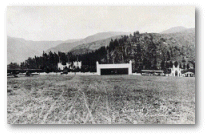 dirt runway, were located at Mountain Street and Grandview Avenue. Activities sponsored by the Aero Club of Southern California and the Commercial Aviation Association helped fuel local aviation enthusiasm. Both organizations, whose members included returning World War I pilots and private airplane owners, recognized a need for a municipal airport in Glendale.
Eager to promote the aircraft industry in the area, these two groups of pilots, headed by Thornton E. Hamlin, appealed to the Glendale Chamber of Commerce to develop a landing field to accommodate private hangars, service facilities, aircraft manufacturing, airmail service, and flights to and from San Francisco. After being convinced that aviation would become an
important industry, the Glendale City Council called a special meeting, and on December 9, 1922, agreed to establish an airport.
dirt runway, were located at Mountain Street and Grandview Avenue. Activities sponsored by the Aero Club of Southern California and the Commercial Aviation Association helped fuel local aviation enthusiasm. Both organizations, whose members included returning World War I pilots and private airplane owners, recognized a need for a municipal airport in Glendale.
Eager to promote the aircraft industry in the area, these two groups of pilots, headed by Thornton E. Hamlin, appealed to the Glendale Chamber of Commerce to develop a landing field to accommodate private hangars, service facilities, aircraft manufacturing, airmail service, and flights to and from San Francisco. After being convinced that aviation would become an
important industry, the Glendale City Council called a special meeting, and on December 9, 1922, agreed to establish an airport.
The Council’s next decision was to determine where the new airport should be built, and they agreed that land owned by John D. Radcliffe would be an ideal location. A committee consisting of City Manager W.H. Reeves, Roy L. Kent, and W.E. Hewitt approached Mr. Radcliffe and was successful in purchasing a 33-acre tract of his land for $2,000 per acre.
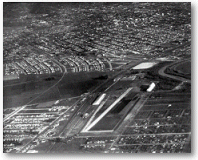 The tract was adjacent and parallel to the Southern Pacific Railroad at the southern end of Grandview Avenue near the Los Angeles River (close to the present-day intersection of the Golden State and Ventura Freeways). Winfield B. Kinner, owner of the Kinner Airplane & Motor Corporation, leased land at the airport site and built the first hangar prior to the official opening of the Glendale Municipal Airport on March 17, 1923. The highlight of the airport's grand opening was an "air rodeo" that included such luminaries as Long Beach stunt-pilot Earl Daugherty, skywriting pilot Captain Leslie Tait-Cox, and sport-plane pilot Amelia Earhart. The event was also intended to rally public support for a bond that would pay for the airport property. When the bond issue failed, public ownership of the airport was short-lived. The Glendale Airport Association, a private syndicate headed by Dr. Thomas C. Young, A.L. Eastman, W.E. Hewitt, Peter L. Ferry, and Roy L. Kent, paid the City of Los Angeles $66,000 and took control of the airport.
The tract was adjacent and parallel to the Southern Pacific Railroad at the southern end of Grandview Avenue near the Los Angeles River (close to the present-day intersection of the Golden State and Ventura Freeways). Winfield B. Kinner, owner of the Kinner Airplane & Motor Corporation, leased land at the airport site and built the first hangar prior to the official opening of the Glendale Municipal Airport on March 17, 1923. The highlight of the airport's grand opening was an "air rodeo" that included such luminaries as Long Beach stunt-pilot Earl Daugherty, skywriting pilot Captain Leslie Tait-Cox, and sport-plane pilot Amelia Earhart. The event was also intended to rally public support for a bond that would pay for the airport property. When the bond issue failed, public ownership of the airport was short-lived. The Glendale Airport Association, a private syndicate headed by Dr. Thomas C. Young, A.L. Eastman, W.E. Hewitt, Peter L. Ferry, and Roy L. Kent, paid the City of Los Angeles $66,000 and took control of the airport.
Because its 1,200-foot runway was considered too short for commercial flights, Glendale Airport’s use remained somewhat limited. Moreover, power lines that flanked the runway created a serious safety hazard. After several accidents occurred during the airport's first year of operation, Dr. Young appealed to the City Council to bury the wires underground. The
Council's failure to respond to this appeal eventually resulted in the airport's first fatal crash. An investigation followed, and because the
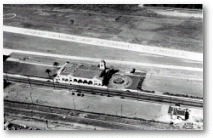 accident involved a Navy flier, the airport was placed off limits to government aircraft. This decision effectively ended Glendale's hopes of making the airport a terminal for the U.S. airmail service.
accident involved a Navy flier, the airport was placed off limits to government aircraft. This decision effectively ended Glendale's hopes of making the airport a terminal for the U.S. airmail service.
Although the Glendale airport was considered unsafe for commercial aviation, it was used extensively by the burgeoning motion picture industry for location and aviation scenes. Hundreds of movies and shorts were filmed in the San Fernando Valley, and consequently several small aviation firms moved into Glendale, particularly from Santa Monica, to get involved
in the entertainment business. While some of these firms offered charter flights, manufacturing, and distribution for other manufacturers, most of them provided piloting services or refurbished private planes. Pilots flew from Glendale Municipal Airport and Griffith Park Aerodrome to perform stunts all around the Valley. Pancho Barnes, granddaughter of the famed
balloonist Thaddeus Lowe, was one of these pilots who set speed records and performed aerial stunts for films. She opened her San Marino home to aviators and the Hollywood crowd, and in 1929, she and others were instrumental in organizing the Associated Motion Picture Pilots to help make movie flying safer. When Howard Hughes wanted to make the ultimate aviation
war film with realistic air combat, he gathered what became the largest private air force in the world on a farmland in nearby Van Nuys for the filming of Hell's Angels (1930) starring Ben Lyon and Jean Harlow. For the movie, an airfield was built in Chatsworth to resemble German facilities. Howard Hawks' The Dawn Patrol (1930), starring Richard
Barthelmess and Douglas Fairbanks, Jr., was also filmed in Chatsworth.
In the late 1920s, aviation in Southern California was primarily limited to a number of small airfields, scattered throughout Los Angeles and the surrounding area. Some of the more well-known and historically significant of these airfields include the
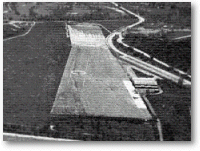 Dominguez Field, where the first International Air Meet in the United States was held in January 1910 at Dominguez Hills; Griffith Park Aerodrome, which was built in 1912 for the Aero Club of Southern California and in 1927 handed over to the state for use by the 115th Observation Squadron of the California Air National Guard (today, the area is a parking lot for
the L.A. Zoo); Mines Field, a tract of farmland west of Inglewood and north of El Segundo, which later became the Los Angeles International Airport; Burdette Airport, home to the famous stunt team "The Black Cats", located at 94th and Western Avenue (later called Dycer Airport); Vail Field, home to Western Air Express since its formation in 1926 and later
called Western Airlines, located at Ferguson Drive and Yates Avenue (southeast of downtown Los Angeles); Montebello Airport, located at Washington Boulevard and Vail Avenue directly across Yates Avenue from Vail Airport (later renamed East Los Angeles Airport); Central Airport, located approximately one mile north of Compton
Dominguez Field, where the first International Air Meet in the United States was held in January 1910 at Dominguez Hills; Griffith Park Aerodrome, which was built in 1912 for the Aero Club of Southern California and in 1927 handed over to the state for use by the 115th Observation Squadron of the California Air National Guard (today, the area is a parking lot for
the L.A. Zoo); Mines Field, a tract of farmland west of Inglewood and north of El Segundo, which later became the Los Angeles International Airport; Burdette Airport, home to the famous stunt team "The Black Cats", located at 94th and Western Avenue (later called Dycer Airport); Vail Field, home to Western Air Express since its formation in 1926 and later
called Western Airlines, located at Ferguson Drive and Yates Avenue (southeast of downtown Los Angeles); Montebello Airport, located at Washington Boulevard and Vail Avenue directly across Yates Avenue from Vail Airport (later renamed East Los Angeles Airport); Central Airport, located approximately one mile north of Compton
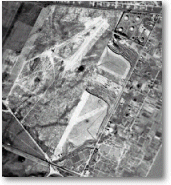 Airport at the intersection of North Central Avenue and 135th Street; Van Nuys Airport, officially dedicated on December 17, 1928, the 25th anniversary of the Wright Brothers' flight, and renamed Los Angeles Metropolitan Airport in 1929; and, of course, the Glendale Municipal Airport.
Airport at the intersection of North Central Avenue and 135th Street; Van Nuys Airport, officially dedicated on December 17, 1928, the 25th anniversary of the Wright Brothers' flight, and renamed Los Angeles Metropolitan Airport in 1929; and, of course, the Glendale Municipal Airport.
Because all of these airfields were limited in their capabilities, a concerted effort was mounted to establish a proper municipal airport for the Los Angeles area. Recognizing a good opportunity, Captain Charles C. Spicer, a World War I fighter pilot, formed a syndicate of venture capitalists in 1928 to purchase and further develop the Glendale Municipal
Airport, whose location made it the best choice for future expansion. Following the purchase, the airport was expanded to the north and west, and eventually encompassed 175 acres. The main runway consisted of 3,800 feet of concrete 100 feet wide, and was aligned with the prevailing northwest-southwest winds. Additional facilities included a 2,500-foot taxi/cross runway. Victor Clark, an aviation publicist and promoter, suggested naming the proposed building and airport facilities "Grand Central Air Terminal." The syndicate unanimously approved the name, and the Grand Central Air Terminal opened on February 22, 1929. The opening ceremonies attracted about 12,000 spectators and over 200 celebrities including Wallace Beery, Gary Cooper, and Jean Harlow.
Designed in 1928 by the prolific architect, Henry L. Gogerty, the Grand Central Air Terminal combined Spanish Colonial Revival with Art Deco styles. Gogerty was born in Zearing, Iowa, and earned his bachelor's degree in architecture and engineering from
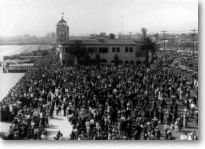 the University of Illinois, as well as a special certificate of architecture from the University of Southern California. After serving in the Army Field Artillery during World War I, Gogerty returned to Southern California in 1923 and established his architectural office in Long Beach, approximately 30 miles south of downtown Los Angeles. Practicing under the name of H.L. Gogerty Associates, his designs included schools, shopping centers, jails, aircraft hangars and terminals, military installations, and commercial office buildings.
the University of Illinois, as well as a special certificate of architecture from the University of Southern California. After serving in the Army Field Artillery during World War I, Gogerty returned to Southern California in 1923 and established his architectural office in Long Beach, approximately 30 miles south of downtown Los Angeles. Practicing under the name of H.L. Gogerty Associates, his designs included schools, shopping centers, jails, aircraft hangars and terminals, military installations, and commercial office buildings.
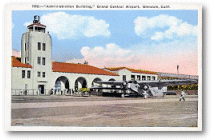 One of the largest industrial projects Gogerty designed was the massive cargo plane assembly building for Hughes Aircraft where Howard Hughes' famous Spruce Goose was constructed. Gogerty remained active until he died in 1990 at the age of 96.
One of the largest industrial projects Gogerty designed was the massive cargo plane assembly building for Hughes Aircraft where Howard Hughes' famous Spruce Goose was constructed. Gogerty remained active until he died in 1990 at the age of 96.
Shortly after the Grand Central Air Terminal's opening, the Curtiss-Keys Group, which controlled several companies including the Curtiss Aeroplane & Motor Company, formed the Curtiss Airport Corporation.
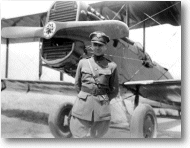 This corporation quickly began purchasing airports serving such cities as Baltimore, New York, Chicago, Philadelphia, Pittsburgh, Louisville, Cleveland and San Francisco. In May 1929, just three months after the opening of Grand Central Air Terminal, the Spicer group sold out to the Curtiss Airport Corporation for approximately $2,000,000. Captain Spicer went on
to become a Curtiss director, as did several of his associates. In June of the same year, Curtiss merged with the Wright Company to become Curtiss-Wright Flying Service. As a result of this merger, the Grand Central Air Terminal became part of the newly formed company. Major Corliss C. Moseley, a World War I fighter pilot and co-founder of Western Air Express
(later called Western Airlines), was selected to manage the airport for the Curtiss-Wright Flying Service.
This corporation quickly began purchasing airports serving such cities as Baltimore, New York, Chicago, Philadelphia, Pittsburgh, Louisville, Cleveland and San Francisco. In May 1929, just three months after the opening of Grand Central Air Terminal, the Spicer group sold out to the Curtiss Airport Corporation for approximately $2,000,000. Captain Spicer went on
to become a Curtiss director, as did several of his associates. In June of the same year, Curtiss merged with the Wright Company to become Curtiss-Wright Flying Service. As a result of this merger, the Grand Central Air Terminal became part of the newly formed company. Major Corliss C. Moseley, a World War I fighter pilot and co-founder of Western Air Express
(later called Western Airlines), was selected to manage the airport for the Curtiss-Wright Flying Service.
As the first airport to offer air service between Los Angeles and New York, Grand Central Air Terminal quickly became the premier airport in Southern California. On July 28, 1929, Charles A. Lindbergh’s affiliated Transcontinental Air Transport (TAT) flew
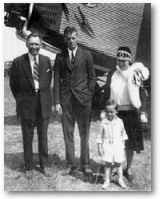 the first regularly scheduled transcontinental flight from Glendale to New York. Lindbergh himself piloted the first leg of the 48-hour flight, and its passengers included Mary Pickford and Douglas Fairbanks, Sr. Later that year, TAT merged with Jack Maddux to become TAT-Maddux. Soon, a number of major airlines began utilizing the airport including Pickwick Airways, which joined TAT-Maddux in offering daily service to San Francisco and San Diego. Because Grand Central Air Terminal provided the public with scheduled commercial service, it became Southern California's primary airport. Various mergers saw the creation of Trans World Airlines (TWA), originally called Transcontinental & Western Air, Inc., which eventually provided service to Glendale from all other major airports nationwide. Unfortunately, it was on a flight bound for Glendale that TWA's worst air crash of the early 20th century occurred. A flight en route from Kansas City to Glendale, involving the last F10A ever built, crashed in Bazaar, Kansas, on March 31, 1931. The two pilots and six passengers, including Notre Dame's beloved football coach, Knute Rockne, were killed.
the first regularly scheduled transcontinental flight from Glendale to New York. Lindbergh himself piloted the first leg of the 48-hour flight, and its passengers included Mary Pickford and Douglas Fairbanks, Sr. Later that year, TAT merged with Jack Maddux to become TAT-Maddux. Soon, a number of major airlines began utilizing the airport including Pickwick Airways, which joined TAT-Maddux in offering daily service to San Francisco and San Diego. Because Grand Central Air Terminal provided the public with scheduled commercial service, it became Southern California's primary airport. Various mergers saw the creation of Trans World Airlines (TWA), originally called Transcontinental & Western Air, Inc., which eventually provided service to Glendale from all other major airports nationwide. Unfortunately, it was on a flight bound for Glendale that TWA's worst air crash of the early 20th century occurred. A flight en route from Kansas City to Glendale, involving the last F10A ever built, crashed in Bazaar, Kansas, on March 31, 1931. The two pilots and six passengers, including Notre Dame's beloved football coach, Knute Rockne, were killed.
The Curtiss-Wright Technical Institute was founded in 1931 and occupied a corner of the Air Terminal building. Under the direction of Major Moseley, the Institute was a school for aircraft technicians, mechanics, and engineers.
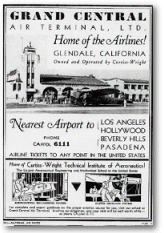 Although it did not offer flight training, flight instruction was available from the Curtiss-Wright Flying Service as an adjunct to courses available by the Institute. In 1933, two pilots, New Jersey surgeon Albert Forsythe and Charles Anderson, landed at Grand Central Air Terminal, becoming the first African Americans to complete a transcontinental flight. The
historic journey led to the creation of the famed WWII corps of black aviators. In 1934, Major Moseley and his associates formed Aircraft Industries, Inc., and leased the entire airport from Curtiss-Wright. This company was an authorized service (aircraft repair and engine overhaul), sales and distributor agent for several aircraft manufacturers. Howard Hughes began secretive aircraft development in a small building at 911 Air Way, on the edge of Grand Central Air Terminal. This was the beginning of the Hughes Aircraft Company whose engineers, along with Hughes, were responsible for developing the H-1 racer. In 1935, Hughes set a speed record of 352 mph in the sleek H-1 racer.
Although it did not offer flight training, flight instruction was available from the Curtiss-Wright Flying Service as an adjunct to courses available by the Institute. In 1933, two pilots, New Jersey surgeon Albert Forsythe and Charles Anderson, landed at Grand Central Air Terminal, becoming the first African Americans to complete a transcontinental flight. The
historic journey led to the creation of the famed WWII corps of black aviators. In 1934, Major Moseley and his associates formed Aircraft Industries, Inc., and leased the entire airport from Curtiss-Wright. This company was an authorized service (aircraft repair and engine overhaul), sales and distributor agent for several aircraft manufacturers. Howard Hughes began secretive aircraft development in a small building at 911 Air Way, on the edge of Grand Central Air Terminal. This was the beginning of the Hughes Aircraft Company whose engineers, along with Hughes, were responsible for developing the H-1 racer. In 1935, Hughes set a speed record of 352 mph in the sleek H-1 racer.
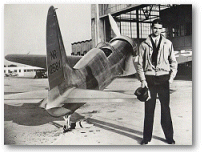 The following year, Hughes set a transcontinental record of 7 hours and 28 minutes from Glendale to New York, a record that would stand against all other aircraft, including military, for the next decade.
The following year, Hughes set a transcontinental record of 7 hours and 28 minutes from Glendale to New York, a record that would stand against all other aircraft, including military, for the next decade.
During the 1930s, Grand Central Air Terminal was directly associated with a number of advances and record settings in aviation history. Furthermore, its close association with the entertainment industry and the architectural uniqueness of the Air Terminal building led movie producers to use it as a film location site in a number of early features. Fox, Grand
National, Warner Brothers, RKO and Universal Pictures all utilized Grand Central Terminal, and it can be seen in such films as Roy Del Ruth's Captured! (1933) starring Leslie Howard and Douglas Fairbanks, Jr. and Lady Killer (1933) starring James Cagney and Mae Clarke; David Butler's Bright Eyes (1934) starring Shirley Temple and James Dunn; Boris Petroff's Hats Off (1936) starring Mae Clarke and John Payne; Busby Berkeley's
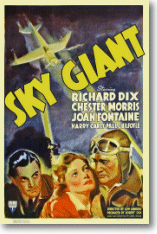 Hollywood Hotel (1937) starring Dick Powell and Rosemary Lane; Lew Landers' Sky Giant (1938) starring Richard Dix and Chester Morris; Ford Beebe and Ray Taylor's 12-chapter serial Sky Raiders (1941) starring Donald Woods and Billy Halop; and Roy William Neill's Sherlock Holmes in Washington (1943) starring Basil Rathbone and Nigel Bruce. In the latter, Grand Central Air Terminal served as the London Terminal of Transatlantic Airways. A humorous filming oversight occurs when Sherlock Holmes and other passengers board the airplane on the tarmac, and palm trees are readily seen in the background - not exactly typical scenery for the London environs. The filming might not have been on location, however. Marjorie Lord, who co-starred in the film, told the author that she remembered the London Terminal scenes being shot on a sound stage with a rear projection image of Grand Central Air.
Hollywood Hotel (1937) starring Dick Powell and Rosemary Lane; Lew Landers' Sky Giant (1938) starring Richard Dix and Chester Morris; Ford Beebe and Ray Taylor's 12-chapter serial Sky Raiders (1941) starring Donald Woods and Billy Halop; and Roy William Neill's Sherlock Holmes in Washington (1943) starring Basil Rathbone and Nigel Bruce. In the latter, Grand Central Air Terminal served as the London Terminal of Transatlantic Airways. A humorous filming oversight occurs when Sherlock Holmes and other passengers board the airplane on the tarmac, and palm trees are readily seen in the background - not exactly typical scenery for the London environs. The filming might not have been on location, however. Marjorie Lord, who co-starred in the film, told the author that she remembered the London Terminal scenes being shot on a sound stage with a rear projection image of Grand Central Air.
Immediately following the Japanese attack on Pearl Harbor, Grand Central Air Terminal was turned into a defense base. The airport's new military function was successfully camouflaged from enemy attack, appearing from the air to be a housing tract
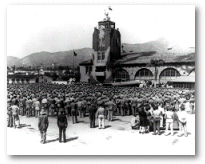 complete with faux streets. Grand Central Air Terminal became the headquarters for the 318th Fighter Wing, which had the responsibility for the operational training of P-38 replacement pilots. The P-38 fighters were large planes that required additional runway space to land and take off. In order to accommodate them, the Grand Central Air Terminal's 3,800-foot runway, had to be lengthened in 1942. This was accomplished by closing off Sonora Street to traffic and paving a narrow strip to Western Avenue, effectively lengthening the runway by 1,200 feet. Curtiss-Wright Technical Institute, with three flight academies, played a key role in the training of approximately 26,000 World War II combat pilots and 7,500 mechanics. During WWII, Grand Central Air Terminal's operations ran 24 hours a day.
complete with faux streets. Grand Central Air Terminal became the headquarters for the 318th Fighter Wing, which had the responsibility for the operational training of P-38 replacement pilots. The P-38 fighters were large planes that required additional runway space to land and take off. In order to accommodate them, the Grand Central Air Terminal's 3,800-foot runway, had to be lengthened in 1942. This was accomplished by closing off Sonora Street to traffic and paving a narrow strip to Western Avenue, effectively lengthening the runway by 1,200 feet. Curtiss-Wright Technical Institute, with three flight academies, played a key role in the training of approximately 26,000 World War II combat pilots and 7,500 mechanics. During WWII, Grand Central Air Terminal's operations ran 24 hours a day.
In 1944, the Grand Central Air Terminal was purchased by Major Moseley and ceased to operate as a commercial airport terminal. At the same time, the name was changed from Grand Central Air Terminal to Grand Central Airport. Additionally, Aircraft Industries, Inc., became known as the Grand Central Airport Company, which would later be reorganized as the Grand Central Aircraft Company in 1950. Its two principal divisions continued to be airplane repair and engine overhaul. Curtiss-Wright Technical Institute, having completed the training of the last class of mechanics, became the Cal-Aero Technical Institute. After the war, hundreds of P-51's, C-47's, B-25's and others transitioned through Grand Central Airport in Glendale for refurbishment and reconditioning.
The runway extension between Sonora Street and Western Avenue was closed in 1947 by municipal decree. The loss of 1,200 feet of runway made the airport a Class II facility, adequate only for small planes (DC-4's and C-54's) coming in for repair and overhaul.
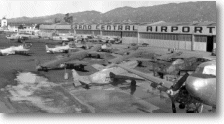 Therefore, larger aircraft, such as the B-29, were sent to the Grand Central Service Center in Tucson, Arizona. At the same time, most of the region's commercial airline service began moving to Los Angeles International Airport. In October 1950, Cal-Aero Technical Institute resumed the training of Air Force mechanics and received additional contracts that extended
this program nearly two years. Overall, 1,200 Air Force men were trained at Glendale, the last of whom graduated in August 1952. By this time, the Air Force was equipped to handle the training quotas without contracting civilian assistance, and Cal-Aero's fortunes declined. In the next couple of years, the student body fell from a high of 1,500 to a low of less than 200. Having lost money for three years, the school closed its doors at the end of the 1954 term. Although Grand Central Aircraft was still the City's largest employer at this time, rising taxes, declining business, and pressure to close the airport and convert the property into a large industrial area resulted in the closure of the Grand Central Aircraft Company in 1959.
Therefore, larger aircraft, such as the B-29, were sent to the Grand Central Service Center in Tucson, Arizona. At the same time, most of the region's commercial airline service began moving to Los Angeles International Airport. In October 1950, Cal-Aero Technical Institute resumed the training of Air Force mechanics and received additional contracts that extended
this program nearly two years. Overall, 1,200 Air Force men were trained at Glendale, the last of whom graduated in August 1952. By this time, the Air Force was equipped to handle the training quotas without contracting civilian assistance, and Cal-Aero's fortunes declined. In the next couple of years, the student body fell from a high of 1,500 to a low of less than 200. Having lost money for three years, the school closed its doors at the end of the 1954 term. Although Grand Central Aircraft was still the City's largest employer at this time, rising taxes, declining business, and pressure to close the airport and convert the property into a large industrial area resulted in the closure of the Grand Central Aircraft Company in 1959.
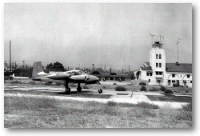 By the mid-1950s, Grand Central Airport's runway and facilities were in need of maintenance. An attempt was made to save a portion of the airport to accommodate the local general aviation community, and a petition requesting Grand Central be converted to a municipal airport was presented to the Glendale City Council. The petition failed to pass, and the airport was officially closed on July 15, 1959. With the end of the airport and aircraft industry, the area became a prime location for light industry. The Prudential Insurance Company purchased the property. Runways were torn out and many new manufacturing buildings were built. Gradually, the area surrounding the Grand Central Air Terminal facility was acquired and modified into the Grand Central Industrial Center (later changed to the Grand Central Business Centre), a 112-acre industrial community consisting primarily of industrial/manufacturing and warehouse/distribution companies. Walt Disney Imagineering, the division responsible for designing Disneyland and other attractions, leased several buildings in the area for many years. The Disney Corporation eventually purchased the entire airport area in 1999, reportedly with a 15-year plan to transform the site into a tree-shaded media campus and to restore the historic Grand Central Air Terminal and control tower as a visitor center.
By the mid-1950s, Grand Central Airport's runway and facilities were in need of maintenance. An attempt was made to save a portion of the airport to accommodate the local general aviation community, and a petition requesting Grand Central be converted to a municipal airport was presented to the Glendale City Council. The petition failed to pass, and the airport was officially closed on July 15, 1959. With the end of the airport and aircraft industry, the area became a prime location for light industry. The Prudential Insurance Company purchased the property. Runways were torn out and many new manufacturing buildings were built. Gradually, the area surrounding the Grand Central Air Terminal facility was acquired and modified into the Grand Central Industrial Center (later changed to the Grand Central Business Centre), a 112-acre industrial community consisting primarily of industrial/manufacturing and warehouse/distribution companies. Walt Disney Imagineering, the division responsible for designing Disneyland and other attractions, leased several buildings in the area for many years. The Disney Corporation eventually purchased the entire airport area in 1999, reportedly with a 15-year plan to transform the site into a tree-shaded media campus and to restore the historic Grand Central Air Terminal and control tower as a visitor center.
The Air Terminal building is located at 1310 Air Way, between Sonora and Grandview Avenues.
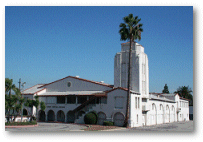 Unfortunately, the interior has been stripped of its ornamental lighting and detailing, and the 1994 earthquake has made it unsafe for occupancy. Nevertheless, its exterior is accessible and is worth the visit, for the Terminal represents one of the last intact original buildings associated with the Golden Age of aviation in the San Fernando Valley. Additionally, two of the original hangars are left. One hangar has been modified as a cold storage facility and the other is being used by Disney Imagineering for special effects mockups.
Unfortunately, the interior has been stripped of its ornamental lighting and detailing, and the 1994 earthquake has made it unsafe for occupancy. Nevertheless, its exterior is accessible and is worth the visit, for the Terminal represents one of the last intact original buildings associated with the Golden Age of aviation in the San Fernando Valley. Additionally, two of the original hangars are left. One hangar has been modified as a cold storage facility and the other is being used by Disney Imagineering for special effects mockups.
Today, the Grand Central Business Centre continues to expand and develop with entertainment, high technology, and manufacturing industries. The Grand Central Air Terminal is listed on the Glendale Register of Historic Resources and there are efforts to have it designated a National Landmark.